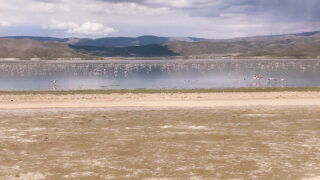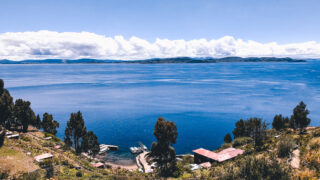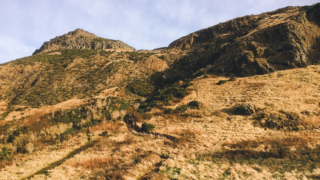When I was planning Bolivia, mountaineering wasn’t on my mind. However, once I discovered that at a height of 6088 m Huayna Potosí is one of the easiest above 6,000 m in the world, I felt it was time to take on a glacier. Acclimatised and unsure what to expect from climbing Huayna Potosí, I walked into Jiwaki and booked a three-day guided trek for the following morning.
During the three-days ice-climbing will be practised, an exhilarating and fun experience. Maybe you will manage to look less like a sloth climbing up the ice-wall. However, if you don’t need to practice ice-climbing you can opt for a two-day tour instead.
Full disclaimer, I never reached the summit due to poor weather conditions. Read on to find out tips, options for when the peak cannot be reached, and why the Huayna Potosí summit should be attempted anyway.

DAY ONE: WHAT TO EXPECT FROM ICE-CLIMBING HUAYNA POTOSÍ
Mentally prepared for a couple of strenuous days we were picked up by a mini-van outside the agency at 8.30 am. Followed by a stop to try on our crampons and the last opportunity to purchase coca sweets, leaves, and snacks. Once the mountain road had led us closer to Huayna Potosí we stopped for a short leg stretch. The sheer height of the glacier towering over you can make any seasoned hiker second guess their ability to reach the summit. From here we continued past alpacas and lakes with mixed feelings of disbelieve of what we are embarking on and excitement.
Once we reached the first camp we ate lunch and said our goodbyes to the guys attempting the incline within two-days. The three of us left went on a short hike to practice ice-climbing. I dreaded this activity, but I was pleasantly surprised by how much fun ice-climbing is. Even though I looked like a sloth climbing up the ice-wall.

DAY TWO: WHAT TO EXPECT FROM HIKING TO HUAYNA POTOSÍ CAMP TWO
The second day is arguably the most strenuous. After breakfast, there was plenty of time to pack our bags. This was an opportunity to leave any non-essential items behind. Trust me, you want your bag to be as light as possible. Packing was followed by a big lunch. They do feed you with plenty of food and snacks. I lived off dulce de leche on crackers. Who can say no to these goodies!

The 3-hour hike to the second camp was exhausting due to the around 18-kilo bags on our backs. I, unlike the others, had no issues with the altitude and my breathing. The trail takes you along paths through the indescribable landscapes of Huayna Potosí. At times, the guides would point out the impact global warming has on the mountain. Part of the way leads over rocks. Let’s be honest the rocks were the aftermath of landslides. Once we arrived at the second camp, we had an early dinner and then the shocking bomb was dropped. Wake-up call at 11.30 pm. I think my jaw dropped and stayed wide open for a while.
DAY THREE: WHAT TO EXPECT FROM HIKING TO THE HUAYNA POTOSÍ SUMMIT IN THE DARK
The 11.30 pm wake-up call was no joke. After breakfast, we made our way to the summit. At this point, it is worth mentioning that our group split into two. One guide went ahead with one hiker and the girls started the hike later with the second guide. The reason for this was that I struggled with stopping every few steps to rest. This was causing me to tire faster than to continuously walk slowly.

The hike on the second day was mostly done in crampons. Unfortunately, it had been snowing heavily throughout the night resulting in non-ideal conditions. However, we were positive at this point, being aware that with two guides for three people we can still carry on if one person gives up. Headlamps on and attached by ropes we steadily made our way through the heavy snowfall.
Only that we heard an avalanche in the close distance at around 5,400 m altitude with the snowfall growing heavier by the minute. At 5,600 m with snow melting below our feet with hours before sunrise and incredibly poor vision we were left with no choice, but to declare ourselves defeated by nature. The conditions resulted in a high risk of another avalanche. Hence, we swallowed our pride and started the decline. Although the guide would have continued if we really wanted to risk our safety.
On the way back to the second camp we didn’t stop once, except for the times we had to jump over gaps in the ground. At this point, we could have asked to try the summit attempt again the following day at an extra charge.
After what felt like a full day at only 5 am I was surprised by my body’s resilience, still felt pride about having been higher than ever before and overcoming my fear of ice-climbing. Overall, this experience was incredible, although defeated by Pachamama. I might have celebrated that with a shot or two.

PREPARATION
It cannot be stressed enough how important it is to properly acclimatise to the altitude before hiking Huayna Potosí. Although this hike is considered minimally physically challenging it is important that you are experienced in hiking, fit, and healthy. Anyone who has hiked in snow before and has properly acclimatised to the altitude in La Paz should be able to reach the summit within two days. Although the extra day allows your body to adjust better, making the hikes easier.

WHAT TO BRING
In late January, the minimum temperature was around 10 degrees. I have heat-tech thermal leggings and a top, keeping you incredibly warm. I didn’t require additional layers other than the fleece and hiking trousers and jackets provided by the agency. Bring hiking shoes but leave your trainers behind. I was wearing thin socks underneath thick ones.
Bring a headlamp and spare batteries if you own one. There is no need for a towel unless you want to pay for a shower at the first camp. Bring around four cereal bars, cocoa leaves, or a bag of cocoa sweets. The tour included plenty of food, therefore you don’t need to bring many snacks.

COST
The Huayna Potosí tour with Jiwaki including equipment, sleeping bag, large rucksack, meals, transport, and guides cost BOB 900 + an entrance fee of BOB 50 paid at the checkpoint before the second camp. My friend paid BOB 850 through a different agency. However, my experience with Jiwaki was excellent although I am unsure what it would be like non-Spanish speakers.
Now go ahead and explore! Try not to lose your towel.


















